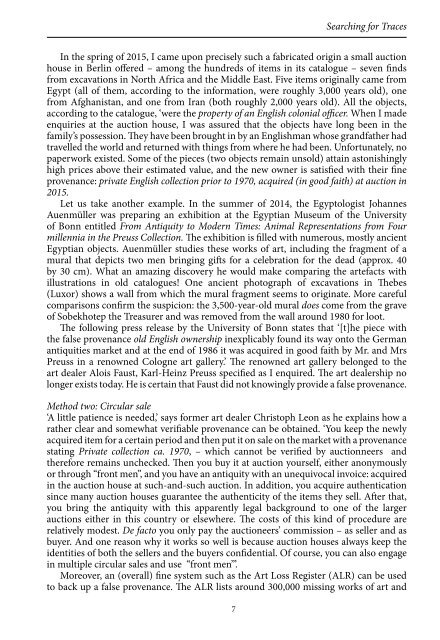Countering
Book_observatory_illicit_traffic_version%20issuu
Book_observatory_illicit_traffic_version%20issuu
Create successful ePaper yourself
Turn your PDF publications into a flip-book with our unique Google optimized e-Paper software.
Günther Wessel<br />
claims to be the world’s largest private database of lost and stolen art and antiques. It can<br />
be used by collectors, the art trade and law enforcement agencies to research items. If an<br />
art dealer sends an inquiry to the ALR, they must contact the police if the artwork was<br />
reported stolen. If verification shows that the piece is not listed in the ALR database as<br />
stolen, the dealer receives a certificate – an initial document that will suggest a sound<br />
source for an antiquity object excavated illegally, and registered in no database. ‘This<br />
way, a dealer can show without risk that they have exercised due diligence,’ says Michel<br />
van Rijn, ‘and they obtain a nice document.’<br />
Silvelie Karfeld, who works on illegal antiquities at the German Federal Criminal<br />
Police Office, has another tip: ‘One can also offer such an item to a museum with only<br />
a low level of risk, so that it is temporarily included in an exhibition as a loaned object.<br />
Then it is published in the exhibition catalogue and thus obtains an apparently legal<br />
background.’<br />
Method three: Forging the paperwork<br />
‘I have come by forged papers, especially in the Middle East,’ says Michel van Rijn.<br />
‘Fanciful provenances are invented. You can always find a notary there to confirm them.’<br />
Helmut Thoma agrees. His Syrian dealer told him that he would bring the large grave<br />
to Switzerland, and there it would also acquire its papers, ‘because the only buyers<br />
who really spent a lot of money on these items were American museums,’ he says,<br />
‘and they wanted to see information about the origin, and so they were provided one:<br />
so-and-so bought the piece 40, 50 or 70 years ago, and has had it in their possession ever<br />
since, and now he’s selling it.’ The Americans were entirely satisfied with that. Christoph<br />
Leon knows how to forge provenances: ‘It’s quite simple: you use old typewriters and<br />
paper to try and write some sort of letter which somehow indicates the origin.’ This said,<br />
‘you must be careful,’ former curator of the Metropolitan Museum of Art, Oscar White<br />
Muscarella forewarns, ‘really careful,’ he insists, and recounts the story of the so-called<br />
Getty kouros.<br />
The Getty kouros is a larger-than-life marble statue that in 1985 was acquired for<br />
9 million dollars by the J. Paul Getty Museum in Malibu, California. It is not known<br />
whether it is authentic or a fake, and the museum acknowledges this. For several years<br />
the label next to the statue was: Greek, about 530 BC, or modern forgery. What matters<br />
most is the provenance of the statue. It first appeared on the art market in 1983, offered<br />
by the Basel art dealer Gianfranco Becchina, and supposedly came from the collection<br />
of a Genevan doctor named Jean Lauffenberger, as Jiri Frel, curator of antiquities at the<br />
Getty Museum, reported to the Board of Trustees. The doctor was said to have acquired<br />
the piece in Greece circa 1930.<br />
‘However, there was no record of the provenance and date of discovery of the kouros,<br />
which eventually brought a little suspicion; all the more so when it became known that<br />
no friends of Lauffenberger’s or his two ex-wives, had ever seen the statue over the half<br />
decade or so it presumably was in his possession,’ Oscar White Muscarella recalls. ‘Just<br />
as suspicion was waning among archaeologists, a couple of letters appeared as if from<br />
nowhere, confirming the Lauffenberger provenance – luckily enough for Frel.’ One of<br />
them was dated 15 March 1952 and sent from Ernst Langlotz, a German archaeologist<br />
wherein Langlotz evoked the style of the kouros. Another letter from 1955, written<br />
by A. E. Bigenwald, a Basel craftsman whom Lauffenberger had contacted, repairs to<br />
the kouros. ‘This seemed to prove its origin,’ says Oscar White Muscarella, grinning in<br />
anticipation of the twist he is about to tell, ‘but the forgers had been careless because<br />
8


